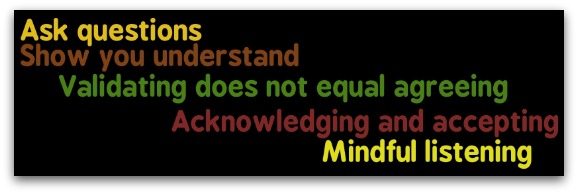Psychology Classics On Amazon

The Single Best Thing You Can Do for Your Relationship
Dr. Shannon Kolakowski
Want To Study Psychology?
Dr. Shannon Kolakowski is a psychologist in private practice in Seattle, helping people with depression, anxiety, and relationship issues. She is the author of When Depression Hurts Your Relationship: How to Regain Intimacy and Reconnect with Your Partner When You're Depressed and Single, Shy and Looking For Love: A Dating Guide for the Shy and Socially Anxious. Dr. Kolakowski writes a blog for the Huffington Post and has been interviewed for publications such as Redbook, Men's Health Magazine, Shape, eHarmony, and ParentMap.
When we think of what we can do to nurture our relationship, we often think of tangibles. Buy her diamond earrings. Take her out to an elegant dinner. Surprise him by wearing sexy lingerie. Buy flowers and chocolate. Take a romantic trip together. While all of these things certainly won’t hurt your relationship (at all!), they aren’t necessarily the strongest ways to connect with your loved one.
The deeper component has more to do with how you interact together rather than what you do together. It’s called validation. Consistent, thoughtful validation of your partner’s thoughts and feelings is the best thing you can do for your relationship.
Think back to a time when you remember feeling really understood. Perhaps it was a caring teacher in grade school who seemed to know exactly the right thing to say when you were upset. Maybe it’s your friend who dropped everything when you called with exciting news and was eager to share your joy. Think back to the last time you really felt heard, understood, and listened to. It’s a powerful feeling, isn’t it?
|
Validation in your relationship is the same idea. It means that when your partner tells you about their day, or shares their feelings, you stay with them in the moment, honoring their experience. You join their world and see things from their point of view. It’s a way of showing you understand and accept their thoughts and feelings just as they are. Research has shown that having these types of interactions with your partner helps your partner feel less upset and less vulnerable, whereas invalidating behaviors do the opposite; they make your partner feel criticized, dismissed, or contempt from you. |
|
Relationships that are the most successful are those where both partners share their inner world with one another — their real thoughts, feelings and desires — and where their partner, in turn, is able to really hear them. When you share a validating style of interacting together, you build trust and intimacy. These are the bonds that make relationships last.
While the concept of validation may seem simple, it can sometimes be a little tricky to execute. Imagine your partner comes home and tells you they are furious because they found out they need to work over the holiday weekend. What is your first reaction? Many of us would feel protective of our spouse, or upset at the situation, and have the natural urge to try to help or fix the situation. You might offer advice on how to solve the problem. While it intuitively feels helpful to give suggestions, this can feel invalidating to your partner. Your partner may not be looking for help with a solution — they probably have already tried to find ways to solve the problem, and might feel even more frustrated in hearing advice, no matter how good your intention.
So how do you effectively listen to and validate your partner? There are a few key components to help guide your conversations.
1. Mindful listening is the first component of validation. This means you really pay attention to what your partner is saying. As difficult as it might be, suspend your own judgments and reactions to the situation or topic. Temporarily let go of the need to advise, change, help or fix the situation. Your own thoughts are put on the back burner; your focus, instead, is on your partner’s current experience. Show you are listening by stopping what you are doing (closing the laptop, turning off the TV), turning to face them, nodding your head, and making eye contact as they talk.
2. Acknowledging and accepting is the next step in validation. This means you acknowledge what they’ve said or what they are feeling. You might say, “I can see you’re upset about this,” or “You seem discouraged” in response to their news about having to work over the weekend. Rather than trying to cheer your partner up, you allow them space to be upset.
3. Validating does not equal agreeing. An important distinction is that you can accept your partner’s feelings, but it doesn’t mean you need to agree with them. For instance, say that you go to see a movie together. Afterward, you discuss your thoughts about the film. Your partner found it entertaining and funny, while you found it boring and predictable. You might validate their point of view by saying, “It sounds like you really enjoyed the film. It wasn’t my favorite, but I can tell that you had fun watching it.” In this example, you’re acknowledging your partner’s enjoyment of something, without sharing the same sentiment.
4. Ask questions. If your partner presents a problem or difficult situation to you, try to find out more about how they are feeling and what they want by asking open-ended questions. “What do you wish would happen?” “What was your reaction to that?” “How are you feeling about things now?” Gently asking questions to clarify their experience can be very gratifying for them. It shows you care and want to really listen.
5. Show you understand. Use validating statements such as, “I would feel that way, too,” or “It makes sense to me that you’d feel that way given the circumstances” to let them know you see why they feel the way they do. You can also show validation with non-verbals, such as giving them a hug if they feel lonely, making them a cup of tea if they feel jittery, or giving them space if they need time to think.
In the end, it’s about the way you interact together, much more so than what you do together. And it can make all the difference in your relationship.
Recent Articles
-
Best Psychology Books for Beginners
Dec 04, 25 07:44 AM
Learn about the mind and behavior with our top picks for the best psychology books for beginners. Start exploring this fascinating field now! -
Best Study Tips for Psychology Students: How to Learn More Effectively
Dec 04, 25 07:16 AM
Discover the best study tips for psychology students. Learn proven techniques, study plans, and habits that make psychology easier, clearer, and more rewarding. -
Why Rage Bait Works: The Psychology Behind Online Outrage
Dec 04, 25 06:11 AM
Discover why rage bait spreads so quickly, the psychology behind engineered outrage, how algorithms amplify it, and what you can do to avoid getting hooked.
New! Comments
Have your say about what you just read! Leave me a comment in the box below.Go To The Dr. Shannon Kolakowski Interview Page







New! Comments
Have your say about what you just read! Leave me a comment in the box below.